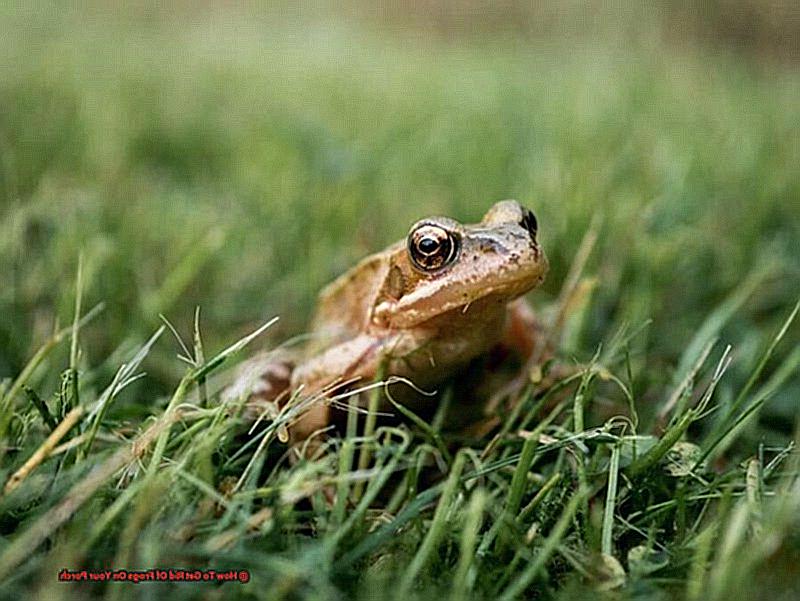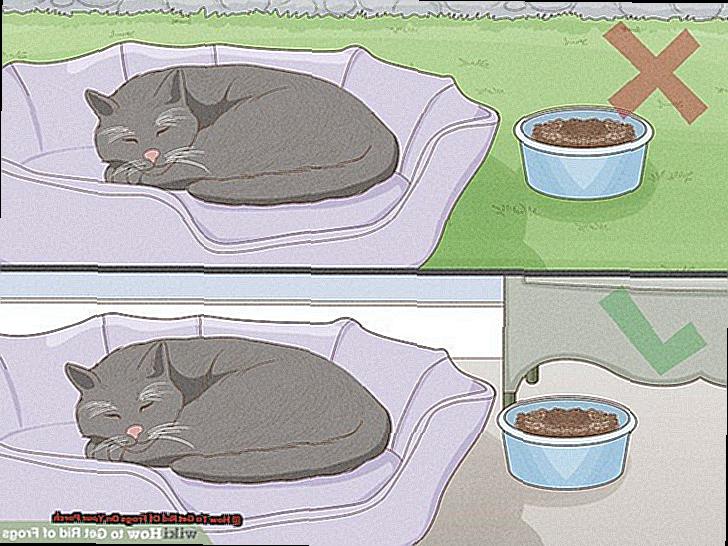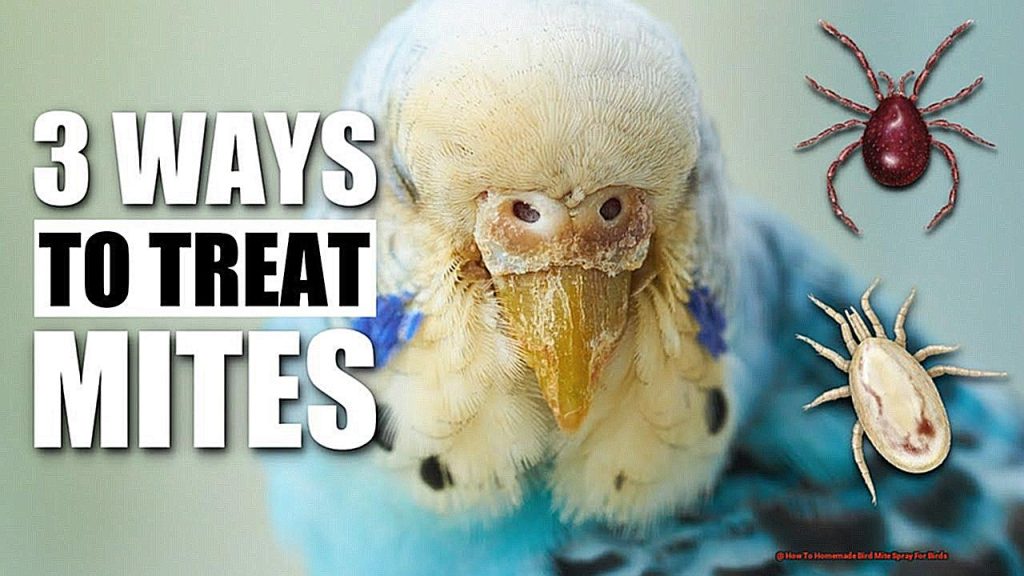Are you tired of constantly shooing away frogs from your porch? Do you find yourself cleaning up their slimy mess every day? Well, fear not, my friend. I have some effective methods for removing these pesky amphibians from your outdoor space. Say goodbye to the constant croaking and hello to a clean and peaceful porch.
But before we dive into the solutions, let’s take a moment to understand why frogs may be drawn to your porch in the first place. It could be due to the abundance of insects, water sources, or shelter provided by plants and clutter. Now that we know the underlying reasons, it’s time to tackle the problem head-on.
Here are some tried and tested methods for getting rid of frogs on your porch:
- Use natural repellents like citronella or garlic spray
- Install motion-activated sprinklers to startle them away
- Place fake predators such as rubber snakes or owls
- Keep your porch clean and clutter-free
- Create barriers using rocks or chicken wire
With these simple yet effective techniques, you can bid farewell to those unwanted visitors and enjoy a frog-free porch once again. So go ahead, grab a cup of coffee, sit back, and read on as we delve into each method in detail. Trust me, it will be worth your while.
Table of Contents
- 1 Frogs: Know Thy Enemy
- 2 Start By Identifying the Frogs in Your Yard
- 3 Methods to Control Frogs in the Yard
- 4 Catching Frogs Using Traps
- 5 How to Kill Frogs Humanely
- 6 Never Kill Native Frog Species
- 7 How to Keep Frogs Out of the Swimming Pool
- 8 Keep Frogs Out of the Yard with a Fence
- 9 Benefits of Having Frogs in the Yard
- 10 Conclusion
Frogs: Know Thy Enemy
There are various kinds of frogs that can be found on porches. These include Leopard Frogs, Green/Bronze Frogs, Carpenter Frogs, Crawfish Frogs, Pickerel Frogs, Wood Frogs, and River Frogs.
- Leopard Frogs: One of the nine species of American water frogs, these frogs can be easily recognized by their green spotted bodies. They are commonly found near water sources such as ponds and rivers.
- Green/Bronze Frogs: These medium-sized frogs are usually found in the Eastern US and can be identified by the distinct skin folds behind their eyes.
- Carpenter Frogs: With light lines running down their back, these frogs are most commonly found along the Southeast coast.
- Crawfish Frogs: These frogs have a light-colored body with spots and skin folds. They can often be found near crawfish habitats.
- Pickerel Frogs: These frogs have two rows of spots between dorsal folds and are typically found in the Eastern US, except for parts of the Southeast and Florida.
- Wood Frogs: These small but hardy frogs have a black mask around their eyes and are commonly found in Northern Boreal Forests.
- River Frogs: These large frogs can grow up to five inches long and are usually found near rivers. Their size, location, and distinctive spots/botches on their sides make them easily identifiable.
To properly identify these common porch frogs, homeowners can take note of their physical characteristics such as size, color, patterns, skin folds, and preferred habitats. They can also seek help from online resources or local wildlife experts for accurate identification.
Start By Identifying the Frogs in Your Yard
To effectively and safely eliminate frogs from your yard, it is crucial to first determine the specific type of frogs present. This will provide valuable insight into their behavior and aid in selecting the most suitable method for managing them. Here are some helpful tips for identifying the amphibians in your yard before taking any action against them:
Consult with Local Wildlife Experts:
The most reliable way to identify the frog species in your yard is by consulting with your local wildlife authority. They are knowledgeable about different frog species and can also inform you about any endangered or invasive species in your area.
Observe Physical Characteristics and Preferred Habitats:
Another way to identify frogs in your yard is by observing their distinct physical features and preferred habitats. Various types of frogs have unique physical traits, such as color patterns, size, and shape, that make them easily distinguishable. They also have specific habitats they gravitate towards, such as ponds, lakes, or wooded areas.
Conduct Research:
Educate yourself on the common frog species found in your region. This will help narrow down the possibilities and simplify the identification process.
Seek Expert Assistance:
If you are still uncertain about the frog species in your yard, consider seeking assistance from experts, such as local herpetologists or wildlife biologists.
Knowing the specific type of frogs in your yard is crucial before attempting to eliminate them.
Methods to Control Frogs in the Yard
To keep frogs from gathering on your porch and taking over your yard, it’s important to understand their behavior. This will help you implement effective methods for controlling them without causing harm to the environment or other animals. Utilizing natural methods, such as creating a frog-friendly habitat in another area of your yard, can also be helpful.
In addition, implementing specific frog control methods, like using barriers or removing potential hiding spots, can make your outdoor space less inviting for frogs.
Regularly maintaining your outdoor space is also key in preventing frogs from taking over. This includes keeping your grass mowed and your yard free of debris, as frogs prefer damp and overgrown areas. Additionally, utilizing prevention techniques like sealing any cracks or gaps in your porch or deck can help keep frogs from entering these areas.
Remember that understanding frog behavior is crucial in effectively controlling them. Frogs are attracted to moisture and insects, so keeping these elements under control can help discourage them from gathering in your yard. You can also try using natural predators, such as snakes or birds, to naturally control the frog population.
By following these methods and regularly maintaining your outdoor space, you can effectively control frogs in your yard without causing harm to the environment or other animals. Remember to be patient and consistent with these techniques.
Catching Frogs Using Traps
There are various methods of ensnaring frogs on your porch that can prove to be highly effective, including net traps, pitfall traps, and sticky traps.
Net traps involve strategically placing a net in an area where frogs are likely to be found, such as near a source of light or in areas with high levels of moisture. On the other hand, pitfall traps require digging a hole in the ground and placing a container filled with water and bait inside.
Sticky traps, coated with a strong adhesive, are designed to capture frogs when they hop onto it.
How to Kill Frogs Humanely
Here are some tips and tricks to help you get rid of them without causing harm.
- Create a barrier: To stop frogs from easily entering your porch, install a fence or mesh wire around its perimeter.
- Use natural repellents: Strong scents like vinegar, coffee grounds, and citronella oil can deter frogs. Give them a try.
- Keep your porch clean: Regularly sweeping and pressure washing your porch will remove food debris and standing water that attracts frogs.
- Install motion-activated sprinklers: Scare off frogs with bursts of water from motion-activated sprinklers that detect movement.
- Use noise deterrents: Loud music and ultrasonic devices that emit high-frequency sounds can help keep frogs away.
- Encourage natural predators: Attract natural predators like snakes and birds by creating a habitat for them or using bird feeders and houses.
By using these humane methods, you can effectively keep frogs off your porch without causing them harm. Remember to consider the context and consult with professionals before taking any action.
Never Kill Native Frog Species
There are multiple humane strategies that can be utilized to eliminate frogs from your porch without causing harm to native frog species. These techniques include altering the porch’s environment, using natural repellents, implementing physical barriers, trap-and-release methods, seeking professional assistance, and prevention techniques.
| Method | Description | Effectiveness |
| Modifying the environment | Maintaining a clean and dry porch, sealing any cracks or gaps | Effective when consistently maintained |
| Natural repellents | Using scents like citronella or vinegar | Short-term effectiveness, requires regular reapplication |
| Physical barriers | Installing mesh screens or wire fencing | Effective if non-harmful to frogs and other animals |
| Trap-and-release methods | Utilizing traps such as funnel traps or bucket traps to capture and release frogs | Highly effective and humane |
| Seeking professional help | Hiring a pest control specialist with expertise in humane removal methods | Effective but may incur cost |
| Prevention techniques | Maintaining the porch and surrounding area, educating others on preserving native frog species | Effective in the long term but requires effort and cooperation from the community |
It is essential to note that utilizing chemicals or pesticides to eliminate frogs from your porch is not recommended as it can harm not only the frogs but also other animals in the surrounding area.
How to Keep Frogs Out of the Swimming Pool
There are several effective methods available to prevent frogs from entering your swimming pool. These include:
- Utilize a Pool Cover: One of the most efficient ways to keep frogs out of your pool is by using a sturdy pool cover. This not only deters frogs from entering, but also provides an added layer of safety for your loved ones and reduces the amount of cleaning needed.
- Turn Off Pool Lights at Night: Frogs are attracted to insects that congregate around pool lights at night. By turning off the lights, you can minimize the number of bugs and discourage frogs from entering your pool.
- Maintain Your Yard: Keeping your yard well-maintained and free of weeds and debris makes it less desirable for frogs, as they prefer areas with a food source like bugs.
- Use Vinegar or Citric Acid Sprays: Spraying vinegar or citric acid along the edges of your pool can irritate frogs’ skin and discourage them from entering.
- Heat Your Pool: Frogs tend to prefer colder water with higher oxygen levels, so heating your pool can make it less appealing to them.
- Spread Coffee Grounds or Install a Fence: Spreading coffee grounds or installing a fence around your pool’s perimeter can also serve as a deterrent for frogs.
- Keep Your Pool Water Circulating: Constantly circulating water is less attractive to frogs, as it prevents the water from becoming an ideal location for them to lay eggs and find food.
- Install Escape Ramps or Devices: If any frogs do happen to enter your pool, installing escape ramps or devices such as “frog logs” can assist them in hopping out on their own.
- Promptly Remove Frogs: It is crucial to promptly remove any live or deceased frogs from the pool, as they can carry diseases and attract other animals like raccoons or rats.
Keep Frogs Out of the Yard with a Fence
Adding a fence to your yard can provide a solid barrier to deter frogs from entering your property. This method is not only effective against frogs, but also other pests. Fences are a low-cost solution that requires regular upkeep, such as burying them at least 6 inches deep into the ground and extending them about 2 feet high for maximum efficiency.
Table:
| Method | Effectiveness | Cost |
| Yard fencing | High | Inexpensive |
| Netting + fencing | High | Inexpensive |
| DIY repellent sprays | Low | Inexpensive |
| Water features (e.g. fountains, waterfalls) | Medium | Varies |
Installing a fence around your yard can be an effective way to keep frogs out of specific areas. The fence serves as a physical barrier, discouraging frogs from entering and causing damage. This method is also budget-friendly and requires minimal maintenance.
To ensure maximum effectiveness, it is crucial to properly maintain the fence. This includes burying it at least 6 inches deep into the ground to prevent frogs from digging underneath. Additionally, extending the fence about 2 feet high will prevent frogs from jumping over it.
Another option is to use netting in combination with fencing. Fine mesh or bird netting can be used to cover plants and provide an extra layer of protection against frogs. This method is also cost-effective and easy to install.
In addition to fencing and netting, homemade repellent sprays can be used to deter frogs from returning. These sprays can be made using common household items like vinegar or lemon juice. Simply spray the solution around the perimeter of your yard to create an unpleasant environment for frogs.
Moreover, adding water features like fountains or waterfalls to ponds can help repel frogs. The constant movement and sound of the water make the area less appealing for frogs to inhabit.
Benefits of Having Frogs in the Yard
Frogs are not just charming and peaceful additions to your yard, they also offer many benefits that can improve the health and balance of your garden ecosystem. Let’s take a closer look at the advantages of having frogs in your yard.
Natural Pest Control:
One of the greatest benefits of having frogs in your yard is their ability to act as natural pest control. These voracious eaters can consume a large number of insects in a single night, making them highly effective at controlling the population of harmful pests like mosquitoes, flies, and other insects.
Bioindicators:
Frogs are excellent bioindicators, meaning they can provide valuable insight into the health of your garden ecosystem. Their presence or absence can indicate the overall health of your garden, as they are very sensitive to environmental changes and pollution. If you have a thriving population of frogs in your yard, it is a good sign that your garden is healthy and well-balanced.
Eco-Friendly Solution:
Unlike chemical pesticides that can harm other beneficial organisms in your yard, frogs offer a natural and eco-friendly solution for pest control. They do not cause harm to plants, and their droppings can even help enrich the soil with their high protein content.
Food Source:
Frogs serve as an important food source for many larger wildlife species such as birds, snakes, and mammals. By having frogs in your yard, you are not only helping maintain the balance of nature but also providing a source of food for other creatures.
To sum up, having frogs in your yard offers numerous benefits such as natural pest control, bioindication, eco-friendliness, and serving as a food source for other wildlife. So next time you see a frog hopping around in your garden, remember that they are not just cute little creatures but also valuable members of your yard ecosystem.
Here are some common frog species that you may encounter in your yard:
| American Bullfrog | Lithobates catesbeianus | One of the largest frogs in North America, known for their deep and booming calls. |
| Green Treefrog | Hyla cinerea | A bright green and small-sized frog with a distinctive call that sounds like a quacking duck. |
| Gray Treefrog | Hyla versicolor | A camouflaged treefrog that can change color depending on its surroundings. |
| Bullfrog | Rana catesbeiana | A large and aggressive species that is a popular source of food in many cultures. |
| Leopard Frog |
Conclusion
In conclusion, the presence of frogs on your porch can be a nuisance, but with the right strategies and understanding of their behavior, you can easily get rid of them. By utilizing natural repellents, installing motion-activated sprinklers, and maintaining a clutter-free porch, you can bid farewell to those pesky amphibians and reclaim your outdoor space.
It’s important to keep in mind that frogs play a vital role in our ecosystem by providing natural pest control, indicating the health of our environment, and serving as food for other wildlife.
Before taking any action against them, consider implementing humane methods or creating a welcoming habitat for them elsewhere in your yard.






